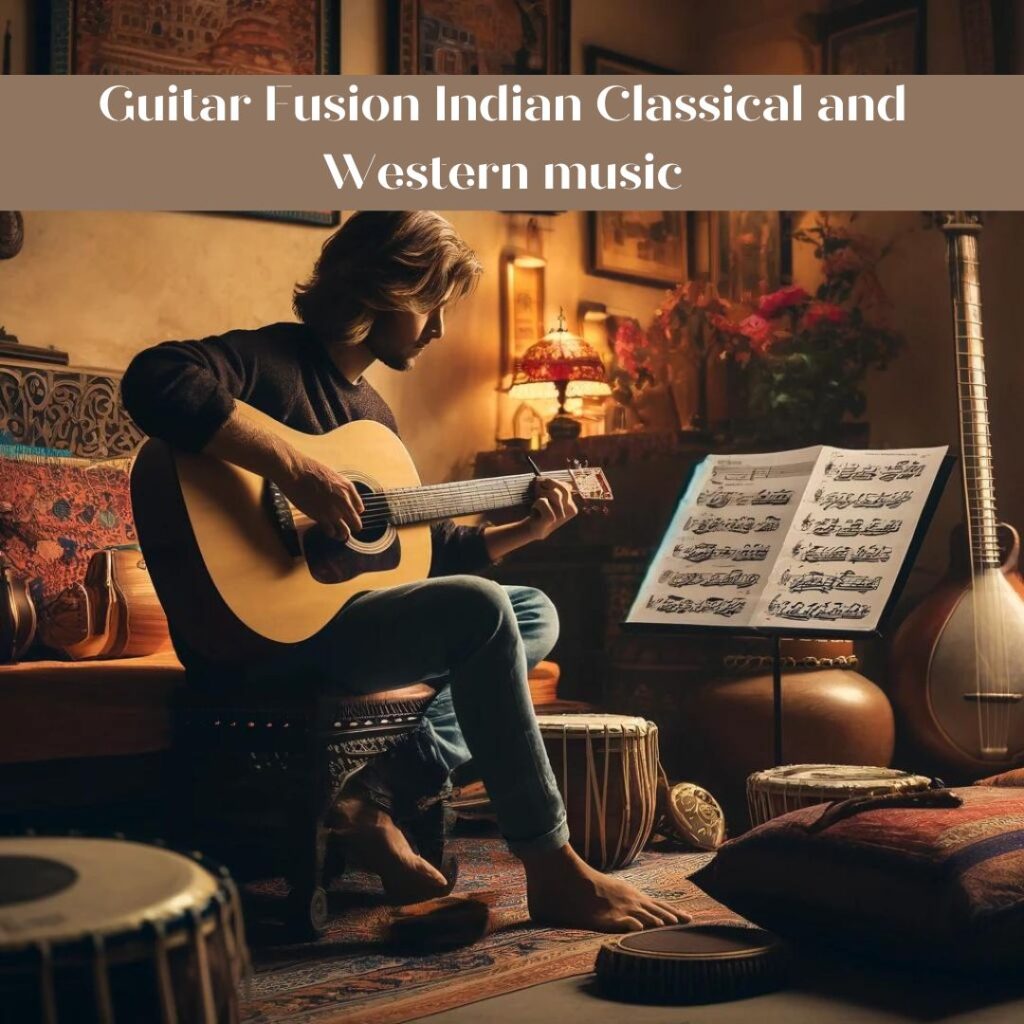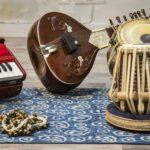| Heading | Subtopics |
|---|---|
| Introduction | The fusion of Indian classical raagas with guitar |
| Understanding Indian Classical Raagas | Basics, importance, and structure of raagas |
| History of Indian Classical Music | Origin, evolution, and significance |
| The Concept of Raagas | Definition, elements, and types of raagas |
| Major Indian Raagas | Popular raagas and their characteristics |
| Basics of Guitar Playing | Essential guitar techniques and skills |
| Importance of Raagas in Music | Role of raagas in Indian classical music |
| Guitar Techniques for Raagas | Adapting guitar techniques to play raagas |
| Fusing Raagas with Western Music | Techniques and challenges in fusion |
| How to Harmonise Raagas | Principles and methods of harmonisation |
| Scales and Modes in Raagas | Understanding scales and modes in raagas |
| Common Raagas for Fusion | Raagas that blend well with Western music |
| Practical Applications | Implementing raagas in various musical contexts |
| Guitar Workshop Overview | Objectives, structure, and benefits of the workshop |
| Choosing the Right Guitar | Selecting a guitar for playing raagas |
| Essential Tools and Equipment | Necessary tools and equipment for the workshop |
| Warm-Up Exercises | Pre-practice exercises for guitarists |
| Basic Raagas for Beginners | Simple raagas to start with |
| Intermediate Raagas | More complex raagas for experienced players |
| Advanced Raagas | Challenging raagas for advanced players |
| Techniques for Effective Practice | Tips and strategies for practicing raagas on guitar |
| Common Mistakes to Avoid | Pitfalls and how to avoid them when fusing raagas with guitar |
| Improvisation with Raagas | Techniques for improvisation and creativity |
| Composing Music with Raagas | Creating original compositions using raagas |
| Performing Raagas Live | Tips for live performances |
| Recording Raaga-based Music | Techniques for recording and producing raaga-based music |
| Case Studies and Examples | Successful fusion of Indian classical raagas in various genres |
| Testimonials from Workshop Participants | Experiences and feedback from previous participants |
| Future Trends in Raaga Fusion | Emerging trends and future directions in raaga fusion |
| FAQs | Common questions and answers regarding the guitar workshop fusing Indian classical raagas and how to harmonise them |
| Conclusion | Summary and final thoughts |
Introduction
The fusion of Indian classical raagas with guitar presents a unique and exciting opportunity for musicians. This blend of Eastern and Western musical traditions creates a rich tapestry of sound that is both innovative and deeply rooted in tradition. In this article, we will explore the fundamentals of Indian classical raagas, their significance, and how they can be harmonised with guitar to create beautiful, melodious compositions.
Understanding Indian Classical Raagas
Indian classical raagas form the foundation of traditional Indian music. A raaga is more than just a scale; it is a melodic framework that evokes specific moods and emotions. Each raaga has its own unique structure and set of rules, including specific note sequences and characteristic phrases that define its identity.
History of Indian Classical Music
Indian classical music has a rich and ancient history, dating back thousands of years. It is divided into two major traditions: Hindustani (North Indian) and Carnatic (South Indian) music. Both traditions share common roots but have evolved distinct styles and repertoires over time. The significance of Indian classical music lies in its spiritual and emotional depth, as well as its sophisticated theoretical foundations.
The Concept of Raagas
Raagas are the heart and soul of Indian classical music. Each raaga is built upon a specific scale and consists of a set of ascending (Arohana) and descending (Avarohana) note patterns. Raagas are also associated with specific times of the day or seasons, believed to enhance their emotional impact. The elements of a raaga include its specific notes (Swaras), key phrases (Pakad), and characteristic movements (Chalan).
Major Indian Raagas
There are hundreds of raagas in Indian classical music, each with its own distinct flavor. Some of the most popular raagas include:
- Raag Yaman: A serene and meditative raaga, often performed in the evening.
- Raag Bhimpalasi: A plaintive and soulful raaga, ideal for expressing longing and devotion.
- Raag Desh: A monsoon raaga, evoking the beauty and romance of the rainy season.
Basics of Guitar Playing
Before diving into the fusion of raagas with guitar, it is essential to have a solid understanding of basic guitar techniques. This includes knowledge of chords, scales, fingerpicking, and strumming patterns. Mastery of these foundational skills will enable you to effectively adapt and play raagas on the guitar.
Importance of Raagas in Music
Raagas play a crucial role in Indian classical music, serving as the melodic basis for compositions and improvisations. They are not just scales but complex frameworks that guide the emotional and spiritual expression of the music. Understanding and mastering raagas can significantly enhance a musician’s ability to create expressive and nuanced performances.
Guitar Techniques for Raagas
Adapting raagas to the guitar requires a blend of traditional guitar techniques and an understanding of the specific requirements of raagas. This includes precise note articulation, the use of slides and bends to mimic the microtonal nuances of Indian music, and the ability to play intricate melodic patterns fluidly.
Fusing Raagas with Western Music
The fusion of raagas with Western music involves integrating the melodic and rhythmic elements of raagas with Western harmonic and structural principles. This can be challenging but rewarding, as it creates a rich and diverse musical palette. Techniques such as modal interchange, polyrhythms, and cross-cultural improvisation are often employed in this fusion.
How to Harmonise Raagas
Harmonising raagas involves blending the melodic contours of a raaga with harmonic progressions. This requires a deep understanding of both the raaga and Western harmony. Techniques include identifying compatible chords, creating harmonic textures that complement the raaga, and using counterpoint to enhance the melodic lines.
Scales and Modes in Raagas
Raagas are based on specific scales or modes, known as Thaats in Hindustani music and Melakarthas in Carnatic music. Each raaga adheres to a specific scale but also includes characteristic phrases and microtonal variations. Understanding these scales and modes is essential for accurately playing and harmonising raagas.
Common Raagas for Fusion
Certain raagas are particularly well-suited for fusion with Western music due to their versatility and melodic appeal. Some of these raagas include:
- Raag Kafi: Known for its bluesy and soulful character.
- Raag Jog: Combines elements of both major and minor scales, making it ideal for fusion.
- Raag Charukeshi: A minor scale raaga with a distinctive and emotional sound.
Practical Applications
Raagas can be applied in various musical contexts, from solo performances to ensemble pieces. They are used in film scores, contemporary music, and even jazz. Understanding how to apply raagas in different settings can expand your musical repertoire and enhance your creativity.
Guitar Workshop Overview
Our guitar workshop fusing Indian classical raagas aims to provide musicians with the skills and knowledge to effectively blend these two musical traditions. The workshop covers the basics of raagas, guitar techniques, fusion strategies, and practical applications. Participants will learn through hands-on practice, guided improvisation, and collaborative performances.
Choosing the Right Guitar
Selecting the right guitar is crucial for playing raagas. A guitar with a warm, resonant tone and good sustain is ideal. Acoustic guitars are often preferred for their natural sound, but electric guitars can also be used with the right amplification and effects.
Essential Tools and Equipment
To effectively participate in the workshop, you’ll need a few essential tools and equipment. This includes a tuner, metronome, slide, and a variety of picks. Additionally, a recording device can be helpful for tracking your progress and evaluating your performances.
Warm-Up Exercises
Before diving into raagas, it’s important to warm up your fingers and hands. Simple exercises such as finger stretches, scales, and arpeggios can help prepare your muscles and improve your dexterity. Consistent warm-ups can also prevent injuries and enhance your playing technique.
Basic Raagas for Beginners
For those new to raagas, starting with simpler raagas can be beneficial. Some basic raagas include:
- Raag Bilawal: A straightforward and joyful raaga, similar to the major scale.
- Raag Bhoopali: A pentatonic raaga that is easy to learn and play.
- Raag Durga: Another pentatonic raaga, known for its simplicity and uplifting character.
Intermediate Raagas
As you progress, you can explore more complex raagas that require greater technical skill and understanding. Intermediate raagas include:
- Raag Bageshree: A romantic and evocative raaga.
- Raag Hamsadhwani: A lively and auspicious raaga, often used to begin concerts.
- Raag Brindavani Sarang: A serene and tranquil raaga, associated with midday.
Advanced Raagas
For advanced players, challenging raagas offer the opportunity to showcase technical prowess and deep emotional expression. Advanced raagas include:
- Raag Marwa: A complex and intense raaga, often performed in the evening.
- Raag Darbari Kanada: A majestic and dignified raaga, traditionally associated with royal courts.
- Raag Todi: A deeply emotional and meditative raaga, performed in the morning.
Techniques for Effective Practice
Effective practice techniques are essential for mastering raagas on the guitar. These include setting specific goals, breaking down complex passages into smaller sections, and using a metronome to maintain a steady tempo. Regular, focused practice sessions can lead to significant improvements in your playing.
Common Mistakes to Avoid
When fusing raagas with guitar, it’s important to avoid common mistakes such as overcomplicating the harmonisation, neglecting the characteristic phrases of the raaga, and ignoring the rhythmic patterns. Staying true to the essence of the raaga while incorporating guitar techniques is key to successful fusion.
Improvisation with Raagas
Improvisation is a core aspect of Indian classical music, and it plays a crucial role in raaga fusion. Techniques such as developing motifs, exploring different rhythmic cycles, and experimenting with dynamics can enhance your improvisational skills. Creativity and spontaneity are essential for engaging and expressive performances.
Composing Music with Raagas
Composing music with raagas involves creating original pieces that blend the melodic structures of raagas with Western harmonies and forms. This requires a deep understanding of both musical traditions and the ability to creatively combine them. Composing can be a rewarding way to explore new musical ideas and express your unique artistic voice.
Performing Raagas Live
Live performances of raaga-based music require careful preparation and practice. Tips for successful performances include understanding the audience, choosing the right raagas for the occasion, and being prepared for improvisation. Confidence and stage presence are also important for engaging the audience and delivering a memorable performance.
Recording Raaga-based Music
Recording raaga-based music involves capturing the nuances and intricacies of the raaga while ensuring high sound quality. Techniques such as using the right microphones, setting up the recording environment, and employing post-production effects can enhance the final recording. Attention to detail and careful planning are essential for producing professional-quality recordings.
Case Studies and Examples
Examining case studies and examples of successful raaga fusion can provide valuable insights and inspiration. Examples include collaborations between Indian classical musicians and Western artists, as well as innovative compositions that blend different musical traditions. Analyzing these examples can help you understand the possibilities and challenges of raaga fusion.
Testimonials from Workshop Participants
Participants in previous workshops have shared their positive experiences and feedback. Many have found the workshop to be a transformative and enriching experience, providing them with new skills and a deeper appreciation for Indian classical music. Testimonials highlight the practical benefits and personal growth achieved through the workshop.
Future Trends in Raaga Fusion
The fusion of raagas with Western music is an evolving field with exciting future trends. Emerging trends include the use of technology to create new sounds, cross-genre collaborations, and the incorporation of raagas into contemporary popular music. Staying informed about these trends can help you stay ahead and innovate in your musical journey.
FAQs
What is the focus of the guitar workshop fusing Indian classical raagas and how to harmonise them? The workshop focuses on teaching participants how to blend Indian classical raagas with guitar techniques and harmonise them effectively.
Do I need prior experience with Indian classical music to join the workshop? No prior experience is required, but a basic understanding of guitar playing is recommended.
What kind of guitar is best for playing raagas? Both acoustic and electric guitars can be used, but a guitar with a warm, resonant tone is ideal.
How long does it take to learn and master a raaga on the guitar? The time required varies depending on the complexity of the raaga and the individual’s practice routine.
Can I apply the techniques learned in the workshop to other genres of music? Yes, the techniques can be applied to various genres, enhancing your overall musical versatility.
Is improvisation a significant part of the workshop? Yes, improvisation is a key component, allowing participants to creatively explore and express raagas.
Conclusion
The fusion of Indian classical raagas with guitar offers a unique and enriching musical experience. By understanding the fundamentals of raagas, mastering guitar techniques, and exploring fusion strategies, musicians can create innovative and expressive compositions. Our guitar workshop provides the knowledge, skills, and practical experience needed to successfully blend these two musical traditions. Join us to embark on this musical journey and discover the beauty of raaga fusion.
============================================
Faculty: Ashish Dey
Instagram:@thepinklotusacademia
Facebook: @thepinklotusacademia
Enquire Now: Click Here
Learn more: The Pink Lotus Academia
Youtube: The Pink Lotus Academia













